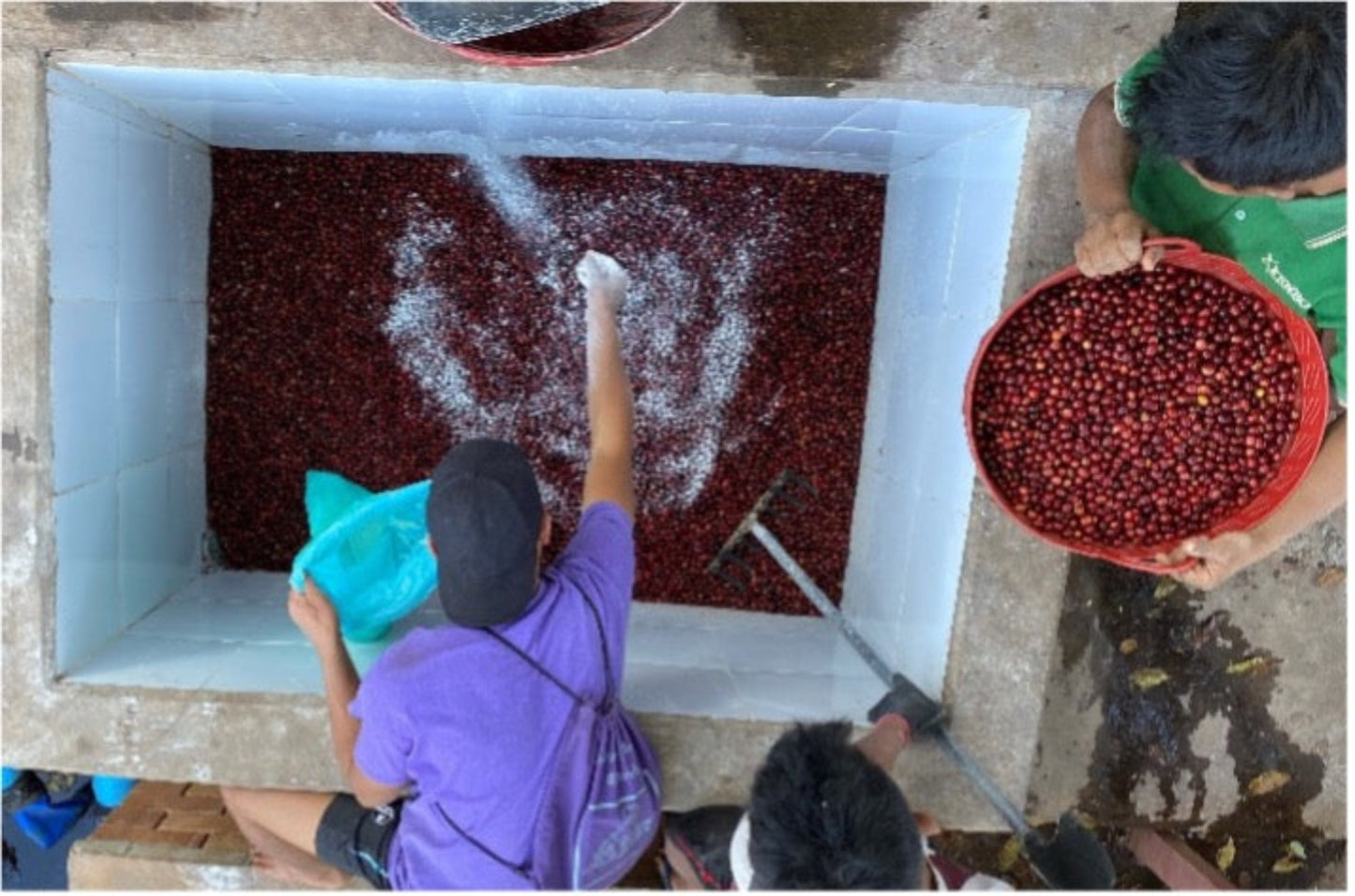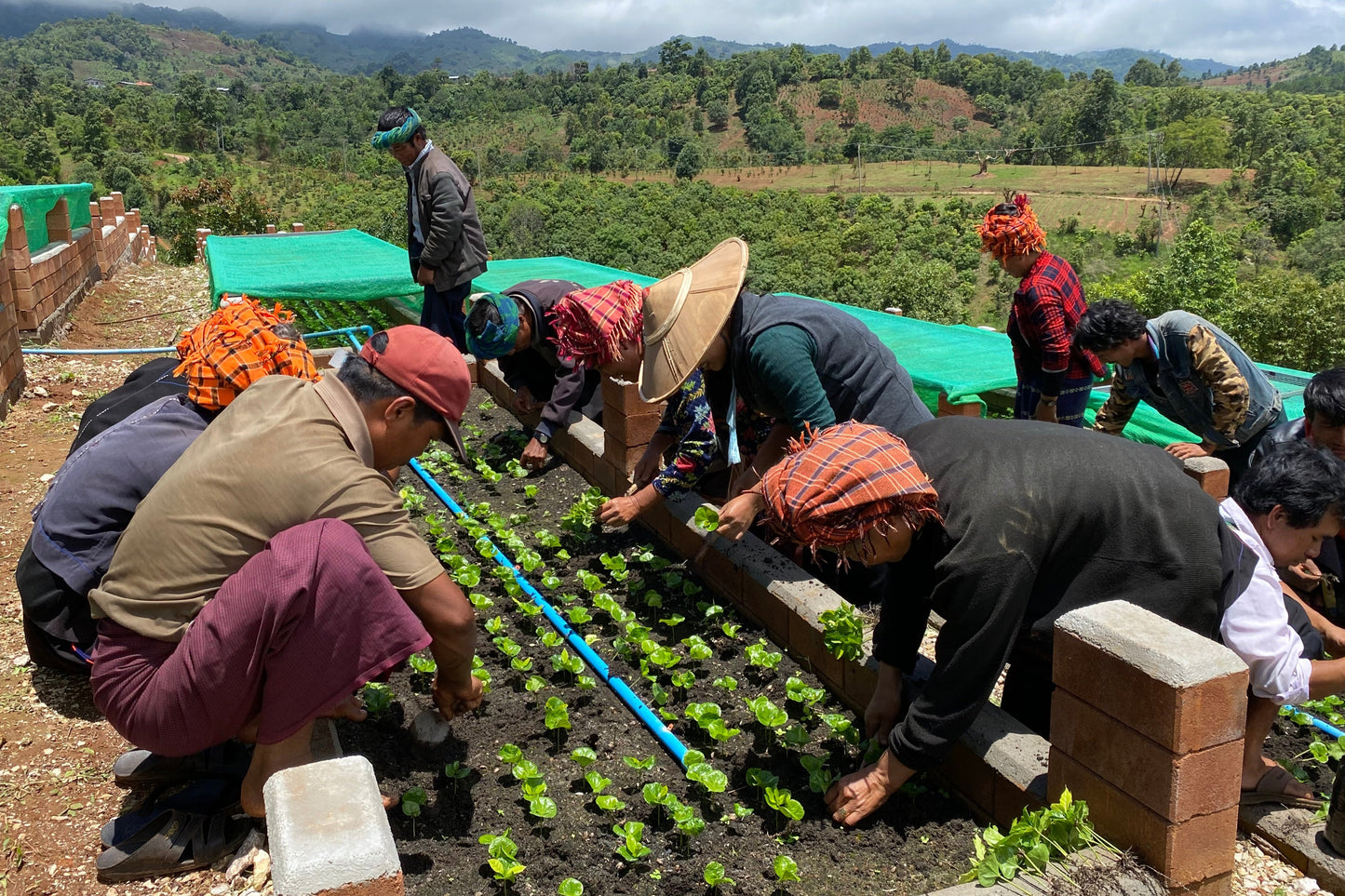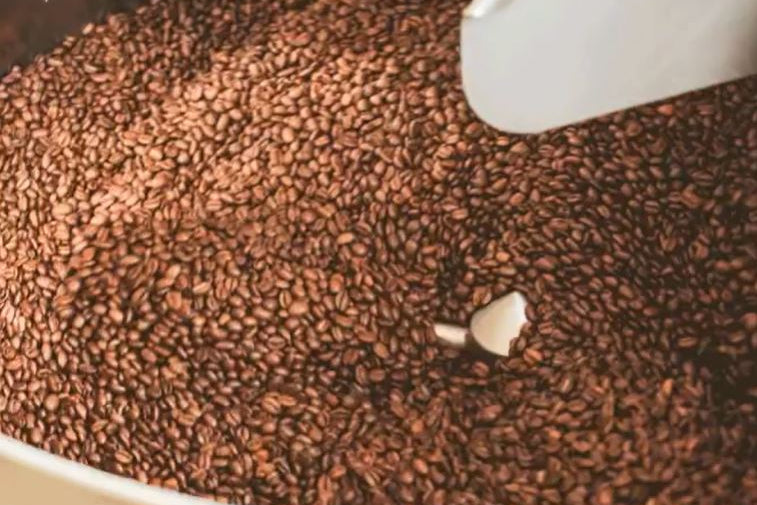ORIGIN SERIES: India
Origin Series delves into coffee growing regions around the world and turns you into a knowledgeable coffee snob.
INDIA’S FLAVOUR PROFILE
Indian-grown Arabica coffee is known for its rich, complex flavour profile, influenced by the country's unique terroir and processing methods. Generally, Indian Arabica exhibits a medium to full body with a smooth, well-rounded mouthfeel. The acidity tends to be mild to moderate, often leaning towards a more balanced, soft acidity rather than sharp brightness. Typical flavour notes include chocolate, nuts, spices, and earthy undertones, with occasional hints of fruit and floral accents. The presence of spices such as pepper and cardamom, often grown alongside coffee, can subtly infuse the beans with unique undertones. Washed Arabica coffees from India are known for their clarity and brightness, while natural and monsooned coffees develop deeper, more intense flavours with low acidity and a syrupy body.
INDIA | RATNAGIRI ESTATE
Origin: India, Karnataka
Farm: Ratnagiri Estate
Farmer: Ashok Patre
Variety: Cauvery
Processing: Nitrogen Natural
Altitude: 1350 masl
Roast Profile: Filter, light
Flavour notes: Pineapple, Mango, Rum
Recommended use: Filter, Aeropress, plunger
Stay tuned for more stories from our Origin Series as we continue to explore the diverse world of specialty coffee.
Discover more about India
India might not be the first country that comes to mind when thinking about coffee, but it has a rich and fascinating coffee-growing heritage that dates back centuries. In fact, even though India is primarily known for its tea production, coffee growing predates coffee. From the misty hills of Karnataka to the biodiverse plantations of Kerala, India’s coffee industry has steadily grown to produce some of the world’s finest beans. Let’s explore the history, growing regions, farming practices, coffee varieties, and processing methods that make Indian coffee truly unique.
India might not be the first country that comes to mind when thinking about coffee, but it has a rich and fascinating coffee-growing heritage that dates back centuries. In fact, even though India is primarily known for its tea production, coffee growing predates coffee. From the misty hills of Karnataka to the biodiverse plantations of Kerala, India’s coffee industry has steadily grown to produce some of the world’s finest beans. Let’s explore the history, growing regions, farming practices, coffee varieties, and processing methods that make Indian coffee truly unique.
Coffee was introduced to India in the 17th century by a Sufi saint named Baba Budan. According to legend, he smuggled seven coffee beans from Yemen on his way back from a pilgrimage in Mecca and planted them in the Chikmagalur region of present-day Karnataka. From these humble beginnings, coffee cultivation spread across the southern parts of India.
During British colonial rule, coffee plantations flourished as the British established large-scale estates and
commercialised production. Early on, Arabica was the most popular export, but Robusta has taken over as the predominantly grown species due to struggles with leaf rust, white stem borer infestation, and climate change. Robusta now makes up over 70 percent of India’s coffee production, although there are producers maintaining and revamping the tradition of growing Arabica.
After India gained independence in 1947, coffee farming was nationalized under the Coffee Board of India, which played a crucial role in organizing and promoting Indian coffee on the global stage. Today, India is among the top 10 coffee-producing countries in the world and grows some of the most genetically diverse coffee due to the country’s historical dedication to proactive breeding.
Coffee was introduced to India in the 17th century by a Sufi saint named Baba Budan. According to legend, he smuggled seven coffee beans from Yemen on his way back from a pilgrimage in Mecca and planted them in the Chikmagalur region of present-day Karnataka. From these humble beginnings, coffee cultivation spread across the southern parts of India.
During British colonial rule, coffee plantations flourished as the British established large-scale estates and
commercialised production. Early on, Arabica was the most popular export, but Robusta has taken over as the predominantly grown species due to struggles with leaf rust, white stem borer infestation, and climate change. Robusta now makes up over 70 percent of India’s coffee production, although there are producers maintaining and revamping the tradition of growing Arabica.
After India gained independence in 1947, coffee farming was nationalized under the Coffee Board of India, which played a crucial role in organizing and promoting Indian coffee on the global stage. Today, India is among the top 10 coffee-producing countries in the world and grows some of the most genetically diverse coffee due to the country’s historical dedication to proactive breeding.
Over the years, repeated battles with leaf rust and an emphasis on yield caused India to increase planting Robusta and prioritise shade growing conditions, much of it in forest conditions. This practice not only enhances the flavour profile of the beans but also promotes biodiversity, prevents soil erosion, and provides a habitat for wildlife such as tigers and elephants. Compared to shade grown coffee in other parts of the world, coffee in India is grown in dense shade conditions, and almost intercropped with peppercorn, cardamom, areca nut, oranges, bananas, and other crops. India is poised to attract increasing attention from specialty markets, and not only because quality is quickly improving.
Farmers rely on both traditional and modern agricultural practices, with many estates focusing on sustainable and organic methods. The monsooning process, a unique post-harvest method where beans are exposed to monsoon winds and rains to develop a distinct flavour, is exclusive to Indian coffee production.
Over the years, repeated battles with leaf rust and an emphasis on yield caused India to increase planting Robusta and prioritise shade growing conditions, much of it in forest conditions. This practice not only enhances the flavour profile of the beans but also promotes biodiversity, prevents soil erosion, and provides a habitat for wildlife such as tigers and elephants. Compared to shade grown coffee in other parts of the world, coffee in India is grown in dense shade conditions, and almost intercropped with peppercorn, cardamom, areca nut, oranges, bananas, and other crops. India is poised to attract increasing attention from specialty markets, and not only because quality is quickly improving.
Farmers rely on both traditional and modern agricultural practices, with many estates focusing on sustainable and organic methods. The monsooning process, a unique post-harvest method where beans are exposed to monsoon winds and rains to develop a distinct flavour, is exclusive to Indian coffee production.
India’s coffee plantations are predominantly located in the southern states, where the climate and altitude create ideal growing conditions. The major coffee-growing regions include:
1. Karnataka (Chikmagalur, Coorg, Hassan)
Karnataka is the largest coffee-producing state, accounting for over 60% of India’s total output. Chikmagalur is often called the ‘Coffee Land of India,’ while Coorg is renowned for its high-altitude Arabica beans. The Western Ghats is one of the three geographical regions in the Karnataka state, with peaks over 2000masl and an average elevation of 1200masl. The mountain range intercepts the westerly monsoon winds that carry rain from the southwest. Coffee thrives in this moist deciduous forest in the mountains, explaining why this is India's coffee production's birthplace.
2. Kerala (Wayanad, Idukki)
Kerala produces both Arabica and Robusta varieties. Wayanad, in particular, is known for its high-quality Robusta beans and shade-grown coffee plantations.
3. Tamil Nadu (Nilgiris, Yercaud, Kodaikanal)
The Nilgiris region is famous for its Arabica coffee, grown at high elevations that contribute to its unique, bright acidity and floral notes.
4. Andhra Pradesh & Odisha (Araku Valley)
This region is gaining recognition for its organic, shade-grown Arabica coffee cultivated by tribal farmers using traditional methods.
5. North Eastern States (Nagaland, Mizoram, Meghalaya, Tripura, Manipur)
Coffee cultivation in the Northeast is still in its nascent stages, but the region's high altitudes and favourable climate show great potential for specialty coffee production.
India’s coffee plantations are predominantly located in the southern states, where the climate and altitude create ideal growing conditions. The major coffee-growing regions include:
1. Karnataka (Chikmagalur, Coorg, Hassan)
Karnataka is the largest coffee-producing state, accounting for over 60% of India’s total output. Chikmagalur is often called the ‘Coffee Land of India,’ while Coorg is renowned for its high-altitude Arabica beans. The Western Ghats is one of the three geographical regions in the Karnataka state, with peaks over 2000masl and an average elevation of 1200masl. The mountain range intercepts the westerly monsoon winds that carry rain from the southwest. Coffee thrives in this moist deciduous forest in the mountains, explaining why this is India's coffee production's birthplace.
2. Kerala (Wayanad, Idukki)
Kerala produces both Arabica and Robusta varieties. Wayanad, in particular, is known for its high-quality Robusta beans and shade-grown coffee plantations.
3. Tamil Nadu (Nilgiris, Yercaud, Kodaikanal)
The Nilgiris region is famous for its Arabica coffee, grown at high elevations that contribute to its unique, bright acidity and floral notes.
4. Andhra Pradesh & Odisha (Araku Valley)
This region is gaining recognition for its organic, shade-grown Arabica coffee cultivated by tribal farmers using traditional methods.
5. North Eastern States (Nagaland, Mizoram, Meghalaya, Tripura, Manipur)
Coffee cultivation in the Northeast is still in its nascent stages, but the region's high altitudes and favourable climate show great potential for specialty coffee production.
India grows both Arabica and Robusta coffee, with a roughly 30/70 production ratio in favour of Robusta. The major varieties include:
1. Arabica Coffee Varieties
- S795 – One of the most widely grown Arabica varieties in India, known for its balanced cup profile, medium body, and mild acidity. It often has subtle nutty and chocolatey flavours.
- SL9 – A hybrid variety resistant to leaf rust, SL9 produces beans with a complex flavour profile, featuring fruity notes and a bright acidity.
- Cauvery (Catimor) – A cross between Arabica and Robusta, Cauvery is valued for its high yield and resilience. It has a strong, full-bodied taste with a mix of chocolate and spice notes.
- Kent – One of the earliest Arabica cultivars grown in India, Kent is prized for its smooth body, bright acidity, and floral undertones.
- Chandragiri – A relatively newer variety, Chandragiri is known for its rich aroma, medium acidity, and hints of caramel and fruit.
2. Robusta
- Popular Varieties: S274, CXR
- Characteristics: Stronger, bolder, with earthy and chocolatey notes, higher caffeine content
- Processing: Often natural (dry-processed), giving it a heavy body and deep flavours.
India grows both Arabica and Robusta coffee, with a roughly 30/70 production ratio in favour of Robusta. The major varieties include:
1. Arabica Coffee Varieties
- S795 – One of the most widely grown Arabica varieties in India, known for its balanced cup profile, medium body, and mild acidity. It often has subtle nutty and chocolatey flavours.
- SL9 – A hybrid variety resistant to leaf rust, SL9 produces beans with a complex flavour profile, featuring fruity notes and a bright acidity.
- Cauvery (Catimor) – A cross between Arabica and Robusta, Cauvery is valued for its high yield and resilience. It has a strong, full-bodied taste with a mix of chocolate and spice notes.
- Kent – One of the earliest Arabica cultivars grown in India, Kent is prized for its smooth body, bright acidity, and floral undertones.
- Chandragiri – A relatively newer variety, Chandragiri is known for its rich aroma, medium acidity, and hints of caramel and fruit.
2. Robusta
- Popular Varieties: S274, CXR
- Characteristics: Stronger, bolder, with earthy and chocolatey notes, higher caffeine content
- Processing: Often natural (dry-processed), giving it a heavy body and deep flavours.
Indian coffee undergoes several processing methods, each contributing distinct characteristics to the final cup profile.
1. Washed (Wet Processing)
This is the most common processing method for Arabica coffee in India. The beans are depulped to remove the outer fruit and then fermented in water to break down the mucilage. After fermentation, the beans are thoroughly washed and dried.
- Impact on flavour: Produces a clean, bright cup with pronounced acidity and clarity of flavours.
2. Natural (Dry Processing)
In this traditional method, coffee cherries are sun-dried with their pulp intact before being hulled to extract the beans. This process takes longer and requires careful monitoring to avoid over-fermentation.
- Impact on flavour: Results in a fuller body with fruity, wine-like notes and lower acidity.
3. Honey Processing
A hybrid method where some mucilage is left on the beans while drying. Depending on the amount left, the process is categorized into yellow, red, or black honey processing.
- Impact on flavour: Adds sweetness and complexity while retaining some acidity and body.
4. Monsooning (Monsooned Malabar
Process)
Unique to India, this method exposes beans to moisture-laden monsoon winds for several weeks. The beans absorb moisture, swell in size, and develop a distinctive golden hue.
- Impact on flavour: Produces a low-acid, smooth, and earthy flavour with a syrupy body, ideal for espresso blends.
5. Fermented Coffee Processing (Experimental Methods)
With the rise of specialty coffee, some Indian estates are experimenting with anaerobic fermentation, carbonic maceration, and yeast-inoculated fermentation to develop unique flavour profiles.
- Impact on flavour: Enhances fruitiness, complexity, and body, creating innovative and diverse cup profile
Indian coffee undergoes several processing methods, each contributing distinct characteristics to the final cup profile.
1. Washed (Wet Processing)
This is the most common processing method for Arabica coffee in India. The beans are depulped to remove the outer fruit and then fermented in water to break down the mucilage. After fermentation, the beans are thoroughly washed and dried.
- Impact on flavour: Produces a clean, bright cup with pronounced acidity and clarity of flavours.
2. Natural (Dry Processing)
In this traditional method, coffee cherries are sun-dried with their pulp intact before being hulled to extract the beans. This process takes longer and requires careful monitoring to avoid over-fermentation.
- Impact on flavour: Results in a fuller body with fruity, wine-like notes and lower acidity.
3. Honey Processing
A hybrid method where some mucilage is left on the beans while drying. Depending on the amount left, the process is categorized into yellow, red, or black honey processing.
- Impact on flavour: Adds sweetness and complexity while retaining some acidity and body.
4. Monsooning (Monsooned Malabar
Process)
Unique to India, this method exposes beans to moisture-laden monsoon winds for several weeks. The beans absorb moisture, swell in size, and develop a distinctive golden hue.
- Impact on flavour: Produces a low-acid, smooth, and earthy flavour with a syrupy body, ideal for espresso blends.
5. Fermented Coffee Processing (Experimental Methods)
With the rise of specialty coffee, some Indian estates are experimenting with anaerobic fermentation, carbonic maceration, and yeast-inoculated fermentation to develop unique flavour profiles.
- Impact on flavour: Enhances fruitiness, complexity, and body, creating innovative and diverse cup profile
- Biodiversity Hotspot: Indian coffee is grown alongside spices like cardamom, pepper, and cinnamon, which can subtly influence the flavour profile of the beans.
- World’s Largest Producer of Shade-Grown Coffee: Nearly all of India’s coffee is shade-grown, making it one of the most environmentally sustainable coffee industries globally.
- The Unique Monsooned Malabar Coffee: India’s Monsooned Malabar coffee is world-famous for its distinct flavour developed during monsoon exposure.
- Arabica vs. Robusta: India is one of the few countries producing high-quality Robusta beans, which are sought after for their strong flavour and use in espresso blends.
- Home to Asia’s First Coffee Plantations: The Baba Budan Hills in Karnataka are considered the birthplace of coffee cultivation in India.
- Biodiversity Hotspot: Indian coffee is grown alongside spices like cardamom, pepper, and cinnamon, which can subtly influence the flavour profile of the beans.
- World’s Largest Producer of Shade-Grown Coffee: Nearly all of India’s coffee is shade-grown, making it one of the most environmentally sustainable coffee industries globally.
- The Unique Monsooned Malabar Coffee: India’s Monsooned Malabar coffee is world-famous for its distinct flavour developed during monsoon exposure.
- Arabica vs. Robusta: India is one of the few countries producing high-quality Robusta beans, which are sought after for their strong flavour and use in espresso blends.
- Home to Asia’s First Coffee Plantations: The Baba Budan Hills in Karnataka are considered the birthplace of coffee cultivation in India.
From the blog
Read the label is a series that breaks down the lingo & helps you choose the coffee that's right for...
ORIGIN SERIES: MYANMAR
We journey to the misty highlands of Myanmar, a Southeast Asian country whose specialty coffee scene is still emerging but...
Blend vs Single origins: what's the difference?
Blends bring balance. Singles bring character. Discover how both fit into your coffee routine — and why neither one has...








